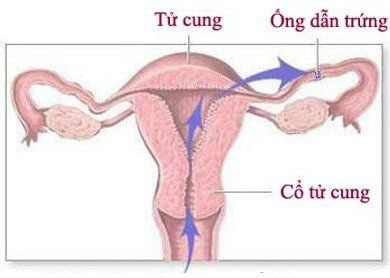This is an automatically translated article.
This article is professionally consulted by: Doctor Nguyen Chi Quang, Obstetrician and Gynecologist, Vinmec Central Park General Hospital. The doctor has many years of experience in the field of obstetrics and gynecology.Ovarian cancer is a dangerous disease, often detected at a late stage, making it difficult to treat. Therefore, today's medicine tends to focus on the prevention of this incurable cancer. Does removing one fallopian tube reduce the risk of ovarian cancer?
1. Fallopian tubes and ovarian cancer
In recent years, scientists have discovered that many cases of ovarian cancer don't even begin in the ovaries, and instead partially arise from cells in the fallopian tubes. . This is the hope that removing the fallopian tubes can prevent ovarian cancer, even before cancer cells appear.Salpingectomy is seen as a promising way to save the lives of women with the most aggressive and deadly form of ovarian cancer - ovarian cancer that originates in the fallopian tubes.
While advanced serous ovarian cancer is thought to start in the fallopian tubes, other forms of ovarian cancer can form in the ovary itself or elsewhere in the body. Because it's still uncertain how many types of ovarian cancer actually start in the fallopian tubes, it's not possible to prevent ovarian cancer by removing both or removing one fallopian tube. absolute efficiency.

2. When is the fallopian tube surgery performed?
Surgery to remove the fallopian tubes is also known as salpingectomy. According to statistics in 2008, only 1 in 250 cases of women who want to be sterilized choose to remove both fallopian tubes or remove one fallopian tube, at which time tubal ligation or electrocautery still work. is being widely applied. However, tubal ablation is becoming more and more common, accounting for one-third of all sterilization procedures in 2011.Clinicians need to discuss with the patient the risks and benefits of tubal ablation to reduce the risk of ovarian cancer. Specifically, women should consider this procedure if they are in one of the following situations:
Had planned a hysterectomy but do not want to have their ovaries removed because of concerns about early menopause and other health risks; Desire for permanent sterilization. While tubal ligation and tubal ligation are both equally effective at preventing pregnancy, tubal ligation may also reduce the risk of ovarian cancer; Are at high risk for ovarian or breast cancer, and have had prophylactic oophorectomy, abdominal or pelvic surgery; Women at increased risk for advanced and advanced serous ovarian cancer should consider tubal removal surgery, as this is the greatest potential risk factor. In summary, the decision to have one fallopian tube removed or both at the same time as the proposed surgery depends on many factors, including individual risk for ovarian cancer as well as the benefits of removal. remove the fallopian tube. However, surgeons should still prioritize choosing the most appropriate and least invasive surgical form for the patient. A patient's chosen surgery should not be intentionally changed just for the "theoretical benefit of tubal ablation."
3. Consider the benefits of tubal ablation
There is an increasing amount of data demonstrating the potential benefit of ovarian cancer prevention by removing the fallopian tubes. One medical study showed that removing both fallopian tubes can reduce the risk of ovarian cancer by 42-78%. Similarly, another meta-analysis found that removing both fallopian tubes at the same time as a hysterectomy reduces the risk of ovarian cancer in women by half.
The long-term risks of tubal ablation are currently unknown. But in the short term, in addition to providing the benefit of preventing ovarian cancer, salpingectomy also does not create significant additional risks for the patient, specifically:
No more time consuming surgery already Nominated; Does not increase surgical complications; Does not prolong the postoperative recovery time. The consideration of tubal removal should be weighed against the risk of ovarian cancer. If the doctor determines the patient is at low risk for ovarian cancer, removing both fallopian tubes or removing one fallopian tube may not be necessary, but the long-term consequences are unknown. But for people at high risk, such as a family history of the disease, patients may choose to have their fallopian tubes removed when they are planning to have pelvic surgery or tubal ligation. If a woman wants permanent sterilization or hysterectomy, she should at least discuss with her doctor whether or not her fallopian tubes should be removed.

4. Consequences and risks of tubal ablation
There is still a lot of controversy around whether tubal removal causes consequences or other health problems.4.1. Linked to Risk of Ovarian Removal The oophorectomy that some women do to prevent ovarian cancer has been shown to be an effective way to prevent most types of genital cancer. women. But the ovaries are responsible for producing important hormones that help protect women against health problems, so removing these organs can cause side effects, such as:
Disease Heart; Lung cancer ; Stroke; Lost memory. Therefore, except when it is absolutely necessary, surgery to remove the ovaries is not recommended because women may have to trade it with the risk of a more dangerous health condition in the future. The same may be true for 2 fallopian tube removal or unilateral tubal ablation.
4.2. Effects of tubal removal surgery Decreased hormone production in case of ectopic pregnancy: According to some studies, removing the fallopian tubes during sterilization does little to change the way the ovaries work. eggs, including hormone production levels. However, when the fallopian tubes are removed in an ectopic pregnancy, where a fertilized egg develops in the fallopian tube instead of the uterus, the way the ovaries then work is also altered. , namely the number of hormones produced.
Still at risk for other forms of ovarian cancer: Besides the unspecified benefits and potential risks of the procedure, another issue with tubal ablation is how well the risk can be prevented. Real ovarian cancer. Currently, there are no effective ovarian cancer screening tools. Aside from certain genetic risks, such as mutations in the BRCA1 and BRCA2 genes, it is not clear what other factors contribute to the risk of all forms of ovarian cancer.
Changes in hormone levels due to tubal ligation: Some studies have also shown that tubal ligation damages the fallopian tubes and changes circulating hormone levels. In summary, removal of the fallopian tubes has the potential to change the function of the ovaries and to have a certain impact on the patient's health. For the patient who wishes to have a tubal ligation and hysterectomy, it is accompanied by: If you are at high risk for ovarian cancer, discuss with your doctor the pros and cons of surgery to remove both fallopian tubes or remove one fallopian tube, as well as the potential benefits and risks of surgery. simultaneous removal of both ovaries. Indications for surgery should be individually planned, based on the patient's goals and condition to ensure the safest and most effective care.
Please dial HOTLINE for more information or register for an appointment HERE. Download MyVinmec app to make appointments faster and to manage your bookings easily.
Reference source: health.harvard.edu












